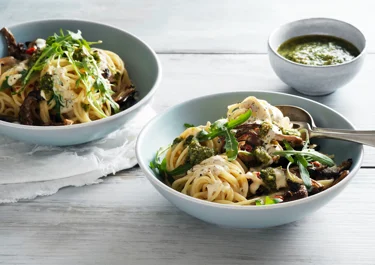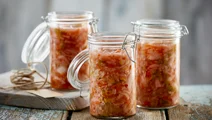
Pasta with pesto

Instructions
Pasta with pesto
Ingredients
Pasta with mushrooms
|
Pasta, e.g. tagliatelle
|
300 g |
|---|---|
|
Mushrooms, e.g. oyster mushrooms
|
400 g |
|
Garlic clove
|
1 |
|
Chilli pepper
|
1 |
|
Butter and rapeseed oil
|
1 tbsp |
|
Salt and black pepper
|
|
|
Double cream
|
200 ml |
|
Rocket
|
65 g |
Pesto
|
Pine nuts
|
25 g |
|---|---|
|
Garlic clove
|
1 |
|
Olive oil
|
1 dl |
|
Medium-aged cheese, grated
|
50 g |
|
Fresh basil
|
1 pot |
|
Black pepper
|
The origins of pesto
Pesto is a thick, roughly ground sauce, traditionally served with pasta. It hails from the city of Genoa in the north Italian region of Liguria, where it’s traditionally made with basil, pine nuts, and parmesan cheese. This green pesto is the famous pesto alla Genovese. Over the years, this delicacy has inspired a number of pesto sauces, made with a wide variety of ingredients. The default pesto is still Genovese, though.
The best type of pasta for pesto
In Italy, the birthplace of pesto, it’s traditionally served with freshly made trofie or spaghetti pasta. These are thin, delicate pasta shapes that capture the pesto and deliver its flavour without too much competition. High-quality dried pasta is easy to recognise by its pale colour and rough surface from the bronze die that shaped the pasta. This surface roughness helps the pesto cling to the pasta. You can of course serve pesto with your favourite pasta shape, such as tagliatelle, penne, or even potato gnocchi.
How to store pasta with pesto
If you have already mixed pesto and pasta, simply refrigerate the pasta in an air-tight container for up to five days. If you have leftover pesto, this can be refrigerated separately for up to five days. Make sure that the container is properly sealed and that there is enough oil in the pesto to cover the basil and other ingredients, preventing them from drying out. Pesto can also be frozen in a freezer-safe container for up to six months.










